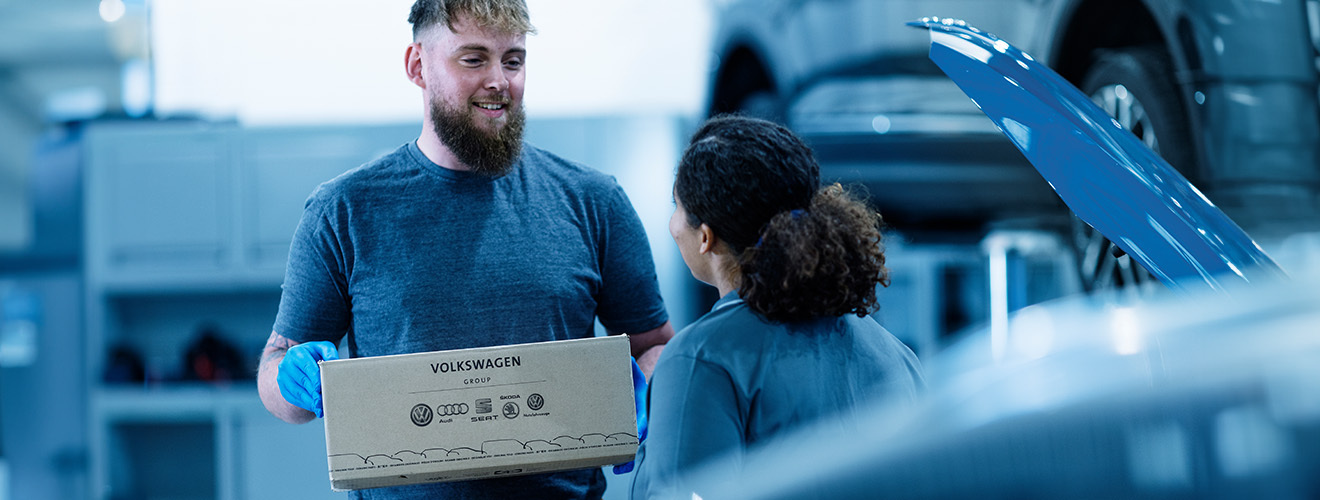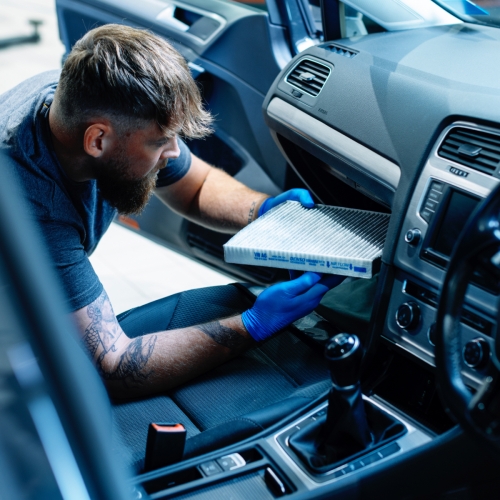Each year the global trade in counterfeit parts brings in over a billion pounds worth of profits for dishonest market players, and plenty of problems for garages and their customers.
For this Insider special, we delve into the differences between Genuine Parts and counterfeit ones, posing as the real deal. Volkswagen Group Parts Product Manager, Adam Hockley casts his expert eye over what makes the fakes and why fitting them to a vehicle can leave motorists counting the cost both in financial and safety terms.
How to spot a counterfeit
The subtle differences between a Genuine Part and a counterfeit part are mostly only exposed through expert knowledge, rigorous laboratory testing and specialist equipment. However, product packaging does offer a more transparent method to spot fake parts.
Adam said: “The packaging a part comes in can sometimes tell a lot about the product’s origin. Low print quality on a box can arouse suspicion even to the most untrained eye.
“Another telltale sign can be a misspelling of the manufacturer’s name, a common error that perfectly demonstrates the careless nature of those dealing in counterfeit parts.
“The packaging used for fake parts is often very low quality and does not last long. It can easily come apart and damage the adjacent parts and components of your car, making it even more dangerous to use.”
Filtering out the fakes
A favoured part for counterfeiters is filters, with oil, fuel, and air filters all subject to being passed off as Genuine Parts by dishonest individuals or groups operating in the market.
For an in-depth understanding of the difference between Genuine Filters and counterfeit ones, lab testing is really useful. When put under a microscope in the lab, the filter element fibres are far denser in the Genuine Part, resulting in better filtering out of harmful particles than the counterfeit part.
As oil filters screen and capture particles that may cause engine damage, counterfeit filters leave harmful particles circulating in the engine, lowering its performance and service life.
The filtering surface of a low-quality filter may also gradually disintegrate, and its elements become an additional cause of the lubrication system clogging.
With fuel filters, a high-quality fuel filter is required for complex and often expensive fuel system components to last long and perform well. If not, various impurities will contaminate the fuel system, causing increased wear and tear.
Adam said: “The counterfeiters will often look to save on material quality, resulting in a reduction of proper filtering. As fuel flow weakens, the engine power then drops, and dirt getting into the engine can clog its nozzles, finally resulting in engine failure.
“Similarly with air filters, the filtering material in a counterfeit filter will fail in terms of quality, density and durability. As a result, counterfeit filters do not allow enough air through and a failure to provide proper engine protection from dust and dirt can ultimately lead to the engine ‘choking’ and losing power.”
Putting a hard stop on fake brakes
Genuine Brake Pads deliver reliable performance even in extreme temperatures and when paired with Genuine Brake Discs will help further guarantee secure braking. The fake brake pads and discs will not, but putting a hard stop on them can often only be identified through rigorous testing.
Adam said: “There are two key tests that can be performed in the lab to differentiate between a Genuine Brake Pad and a counterfeit one; the friction coefficient and the ultimate shear strength tests.
“When brake force is applied through the brake disc to the brake pads, it’s transmitted through a special friction material that creates friction when pressed against a brake disc and stops the car.
“The higher the friction coefficient, the better braking performance you get. A counterfeit brake pad has a lower friction coefficient than the Genuine equivalent, meaning that its braking performance will degrade with an overheated brake mechanism, increasing the possibility of a traffic accident.
“The ultimate shear strength tests help evaluate the quality of the bond between the friction layer and the brake pad base. In one such test, two brake pads, Genuine and counterfeit brakes are mounted on a test bench with force applied to the friction material sideways until it fully tears off.
“With the ultimate shear strength standard set at 250 N/cm2, the Genuine Brake Pad performs at 350 N/cm2 – well above the standard. By contrast, the fake brake pad performs at 202 N/cm2 – below the required standard and with the greater likelihood that it may break during sudden braking, resulting in the driver losing control of the car.
“For brake discs, the difference between the Genuine and the counterfeit parts is again a stark one, with further risks posed.
“Genuine Brake Discs are reliable even at extreme temperatures and can withstand at least 500 consecutive emergency braking cycles without cracking. They are also highly resistant to geometry changes - meaning you will feel no vibration during braking - all of which help to ensure maximum safety for the driver and passengers.
“By contrast, a fake brake disc is an untested deception, with its composition, strength, and resistance to high temperatures all completely unknown. As a result, it further increases the possibility of a brake disc meltdown, which during sudden braking from a high speed is one of the most life-threatening situations possible when driving a car on the road.”
In summary: Why buy Genuine Parts
Adam said: “While some counterfeit parts can be identified through obvious signs such as poor quality packaging, many fake parts on the market may only be exposed by rigorous testing procedures carried out in laboratory conditions.
“When purchasing parts the best overall advice to garages and their customers is to always source them from recognised factors and suppliers.
“By purchasing parts in this way you will know that you are buying legitimate parts built to the highest standards and covered by extensive warranties.
“Volkswagen Group Genuine Parts are identical in quality to the parts used in new-vehicle production and are designed to fit the first time – which means saving time and money in the workshop.
“They have also been manufactured to exactly Volkswagen Group standards and come with the reassurance of a two-year warranty*"
*excludes wear and tear




